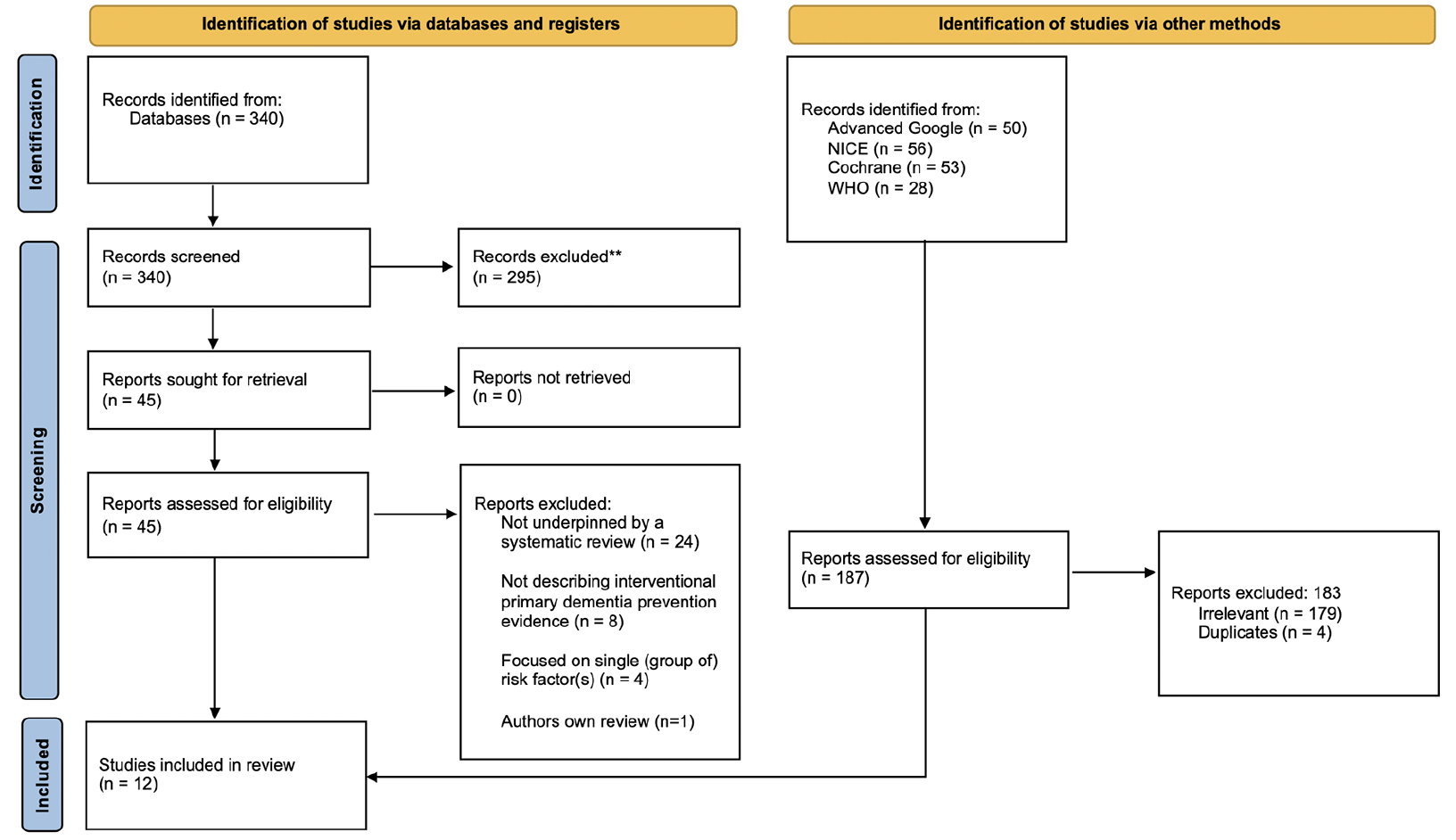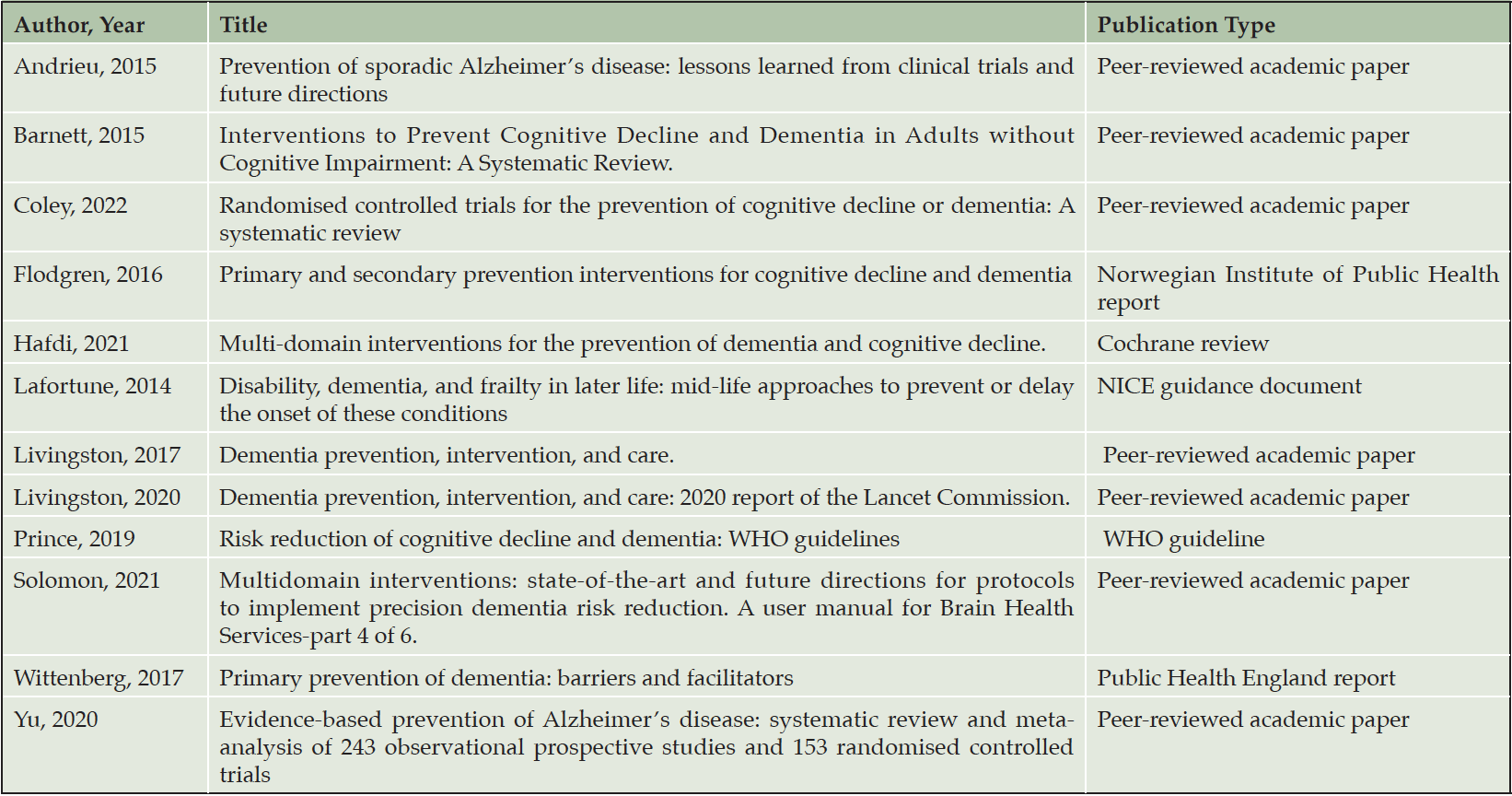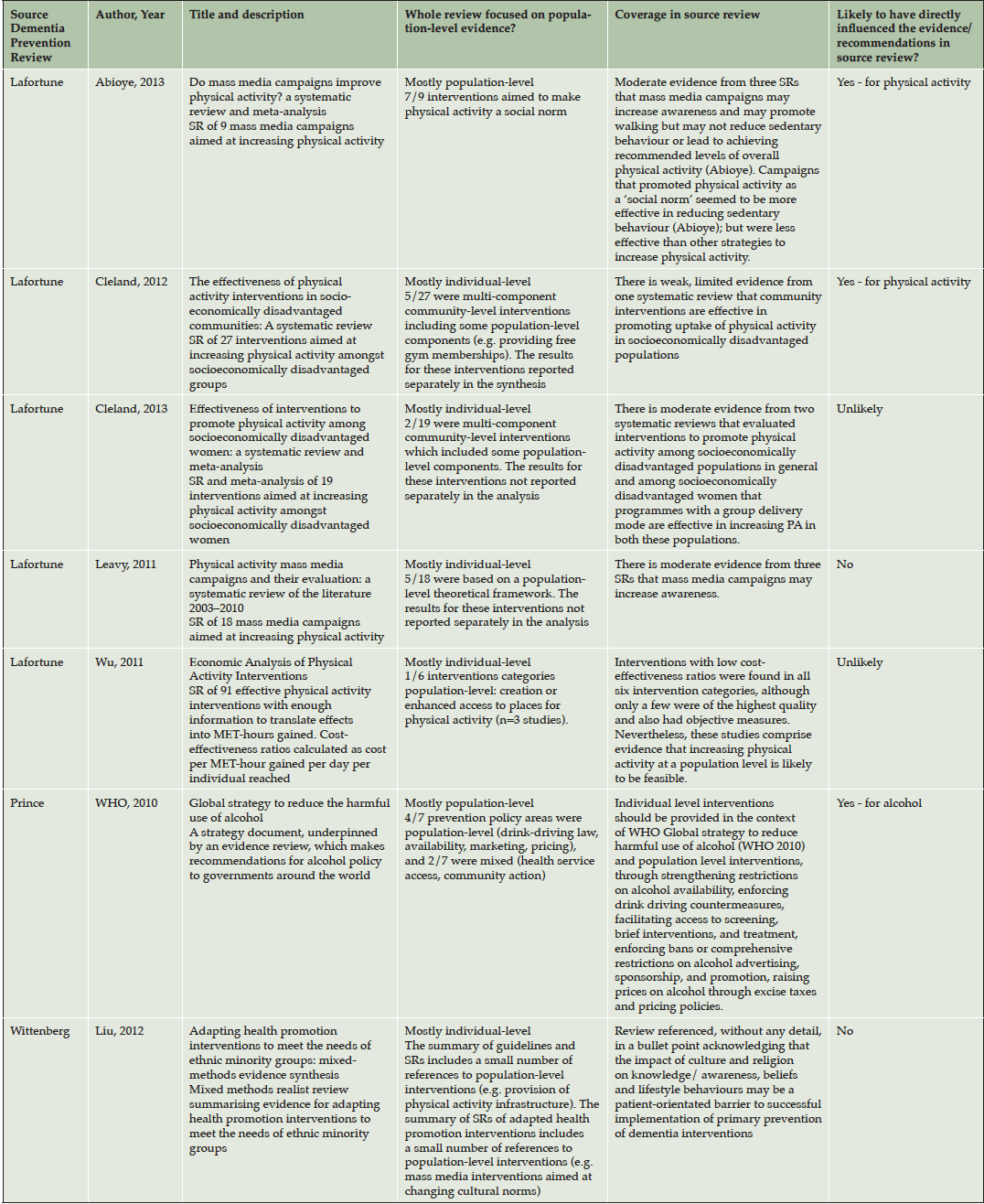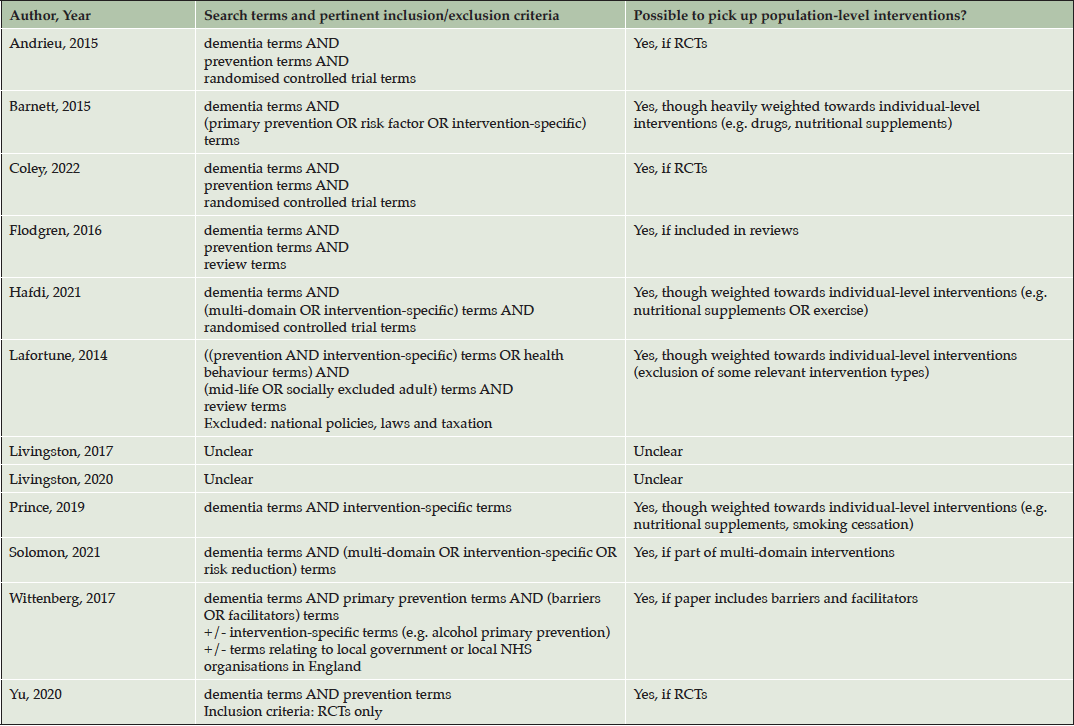S. Walsh1, L. Wallace1, I. Kuhn2, O. Mytton3, L. Lafortune1, W. Wills4, N. Mukadam5, C. Brayne1
1. Cambridge Public Health, University of Cambridge, Cambridge, UK; 2. University of Cambridge Medical School Library, School of Clinical Medicine, Cambridge, UK; 3. Great Ormond Street Institute of Child Health, University College London, London, UK; 4. Centre for Research in Public Health and Community Care, University of Hertfordshire, Hatfield, UK; 5. Division of Psychiatry, University College London, Maple House, London, UK
Corresponding Author: Dr Sebastian Walsh (MBChB, MPhil), Cambridge Public Health, Forvie Site, Robinson Way, Cambridge, CB2 0SR, UK, Tel: 01223 330 300, Fax: +44 01223 748600, Sjw261@medschl.cam.ac.uk
J Prev Alz Dis 2024;1(11):241-248
Published online May 15, 2023, http://dx.doi.org/10.14283/jpad.2023.57
Abstract
Dementia is forecast to become increasingly prevalent, particularly in low- and middle-income countries, and is associated with high human and economic costs. Primary prevention of dementia -preventing risk factors leading to disease development – is an emerging global public health priority. Primary prevention can be achieved in two ways: individual-level or population-level. In this rapid review, we quantify the proportion of contributing interventional evidence to the dementia primary prevention literature that is concerned with either approach. We searched Medline, the National Institute for Health and Care Excellence, Cochrane, the World Health Organization, and Google to identify systematic reviews that described primary prevention interventions for dementia. We used search terms related to dementia risk reduction, intervention/policy, and review. We analysed reference lists of included dementia prevention reviews to identify contributing primary prevention evidence, and categorised these as either individual-level or population-level. Additionally, we examined search strategies to investigate the likelihood of reviews identifying available population-level interventions. We included twelve of the 527 articles retrieved. Population-level evidence was summarised by only two reviews. In these two reviews, <2.5% of the interventions described where population-level interventions. Most search strategies were weighted towards identifying individual-level evidence. Existing systematic reviews of dementia primary prevention interventions include almost no population-level evidence. Correction of this imbalance is needed to ensure that dementia prevention policies can achieve meaningful reductions in the prevalence of, and inequalities in, dementia.
Key words: Dementia, primary prevention, population-level approaches.
Introduction
Dementia is forecast to become increasingly prevalent, particularly in low- and middle-income countries (1). Dementia is associated with high human and economic costs (2), and available treatments are minimally effective at best (3–5). Observational data have suggested that incidence has reduced in high-income countries (6), and have pointed to potentially modifiable risk and protective factors (7). Therefore, primary prevention of dementia – preventing risk factors leading to the development of disease – is an emerging global public health priority (8).
Primary prevention can be categorised into two main types: individual-level or population-level (9). Individual-level approaches place the onus on individuals, usually those identified as high-risk for disease development, to lower their risk by changing their behaviours. Population-level approaches attempt to shift the risk distribution of the whole population, by changing the structural, societal conditions that drive risk and protective factor development and maintenance (9). Population-level approaches can result in more substantial incidence and prevalence reductions, greater health equity, and longer-term effects, than individual-level approaches (10, 11). However, they tend to be more academically challenging to research, and more politically challenging to implement, and are therefore likely to be under-researched, creating a cycle of absence of evidence for policymakers (10, 11). In this rapid review, we examine the dementia primary prevention literature to quantify the proportion of contributing interventional evidence that is population-level as compared to individual-level, to understand whether population-level approaches have been under-researched for dementia primary prevention.
Methods
The protocol for this rapid review was registered on Open Science Framework https://osf.io/ps736/.
Search strategy
We developed the search strategy with a medical librarian (IK). We searched Medline via Ovid on 10/11/22 for terms related to dementia risk reduction AND (intervention OR policy) AND review, limiting to articles published in the last 10 years (since 01/01/2013). In addition, we conducted grey literature web-searches on the websites of the National Institute of Health and Care Excellence (NICE), Cochrane reviews, the World Health Organization (WHO), and an advanced google search, for terms related to dementia and prevention. The full search strategy is available in appendix A.
Inclusion and exclusion criteria
In order to achieve a pragmatic overview of the dementia primary prevention literature, we excluded reviews that focussed only on one proposed risk factor, or one group of risk factors (e.g. physical activity interventions), including only reviews that aimed to summarise the breadth of dementia primary prevention interventions. We excluded reviews that were not informed by systematic literature searches.
Study selection
Articles from all database and grey literature searches were uploaded to the Rayyan systematic review webtool (12). Two researchers (SW and LW) independently screened articles by title and abstract, and read any potentially relevant articles in full to determine eligibility. Conflicts were resolved by discussion.
Data extraction
Data were extracted by one reviewer (SW), and checked by another (LW), into a pre-determined template.
The reference lists of the included dementia prevention reviews were analysed, to identify contributing evidence which described primary prevention interventions or policies. Primary prevention interventions were defined as those involving cognitively healthy participants, with at least one outcome measure of cognitive decline, dementia, or a modifiable risk or protective factor for incident dementia. The references were reviewed by title and/or abstract, and full texts were retrieved for any potentially relevant articles.
The references were then categorised as: individual-level or population-level. If contributing evidence was referenced in the form of a review rather than primary evidence, then the individual studies contributing to that review were examined to determine whether the review summarised individual-level interventions only, population-level interventions only, or mixed interventions. Population-level interventions were defined as ‘measures applied to populations, groups, areas, jurisdictions, or institutions with the aim of changing the social, cultural, physical, commercial, economic, environmental, occupational, or legislative conditions to make them less conducive to the development or maintenance of the modifiable lifecourse risk factors for dementia, and/or more conducive to the development or maintenance of the modifiable lifecourse protective factors for dementia’ (13). Any intervention not meeting the definition of a population-level intervention was considered to be individual-level.
For each contributing article that described a population-level intervention, we reviewed how this reference was summarised by the source dementia prevention review. We then made a judgement as to how much the population-level evidence had contributed to the evidence presented by, and recommendations made by, the source dementia prevention review.
Lastly, we reviewed the search strategies used by the dementia prevention reviews to identify interventional evidence, and extracted the search terms used.
Data synthesis
We quantified the proportion of contributing primary prevention articles which described individual-level and population-level interventions. The contributing population-level evidence was described narratively, grouped by intervention design, and risk factor targeted.
The search terms used by the dementia prevention reviews were analysed, with a judgement made on the likelihood of these reviews identifying population-level primary prevention evidence that was available. The findings of this search strategy analysis were reported narratively.
Results
The searches produced 527 articles in total for screening (figure 1), of which 340 came from a formal database and 187 came from the grey literature. Of the database articles, 45 were read in full to assess for eligibility, and eight dementia prevention reviews (7, 14–20) were included. We included four (21–24) (Google search n=3, NICE search n=1) articles from the grey literature.
One article (13) was excluded, despite meeting the inclusion criteria, because it was conducted by members of this author group, since the present article was conceived, with the explicit intention of increasing the population-level dementia primary prevention evidence base (i.e. that review, and the present review, are linked parts of the same research focus).
Dementia prevention (source) reviews
The included dementia prevention reviews are shown in table 1. Of the twelve included reviews, eight were peer-reviewed academic papers, including one Cochrane review (20), two were from national public health agencies (21, 23), one was a guidance document from the WHO (22), and one was an evidence review to inform NICE guidance (24). Two reviews (7, 14) were updates of other included reviews (18, 19).
NICE = National Institute for Health and Care Excellence. WHO = World Health Organization
Contributing primary prevention evidence
Review of the reference lists of the included dementia prevention reviews identified seven papers which described population-level prevention interventions (25–31) (table 2). These seven references came from three source reviews (22–24); meaning that nine of the twelve included dementia primary prevention reviews referenced zero population-level dementia risk reduction evidence.
SR = Systematic Review. WHO = World Health Organization
All seven referenced articles describing population-level interventions were review documents which included evidence on the effectiveness of both individual-level and population-level interventions. In five (26–30) of these reviews, most of the contributing evidence was for individual-level interventions; only two predominantly included population-level evidence (25, 31). Five of the reviews considered interventions to increase physical activity, mostly through mass media interventions that aimed to change sociocultural norms (27–31), one reported interventions to reduce excess alcohol consumption, e.g. restricting marketing or reducing availability (25), and one reported “health promotion” interventions (e.g. healthier diets, more physical activity) amongst ethnic minority groups – with the contributing population-level evidence mainly for physical activity (26).
Because the population-level interventions in the contributing evidence were contained within reviews that described both individual-level and population-level interventions (rather than primary studies that described only one intervention), the extent to which the population-level intervention evidence specifically influenced the reporting and recommendations of the source dementia prevention reviews was unclear. It is possible that when the source dementia prevention reviews were extracting and considering these contributing reviews in their totality, the population-level evidence did not significantly contribute to the overall impression presented – particularly for the five contributing reviews which predominantly described individual-level interventions. Analysis of the way that the contributing articles were summarised in the source dementia prevention reviews found only three occasions in which population-level evidence (25, 30, 31) was likely to have directly influenced the writing of the source dementia prevention reviews (22, 24).
Table 3 summarises the number of dementia primary prevention interventions included by each source dementia prevention review, and what percentage of this evidence was targeted at the population-level. In ten of the twelve dementia prevention reviews, none of the directly contributing primary prevention evidence was population-level; in the other two reviews, population-level evidence contributed trivial amounts (2.3% (22) and 2.4% (24)) of the contributing evidence.
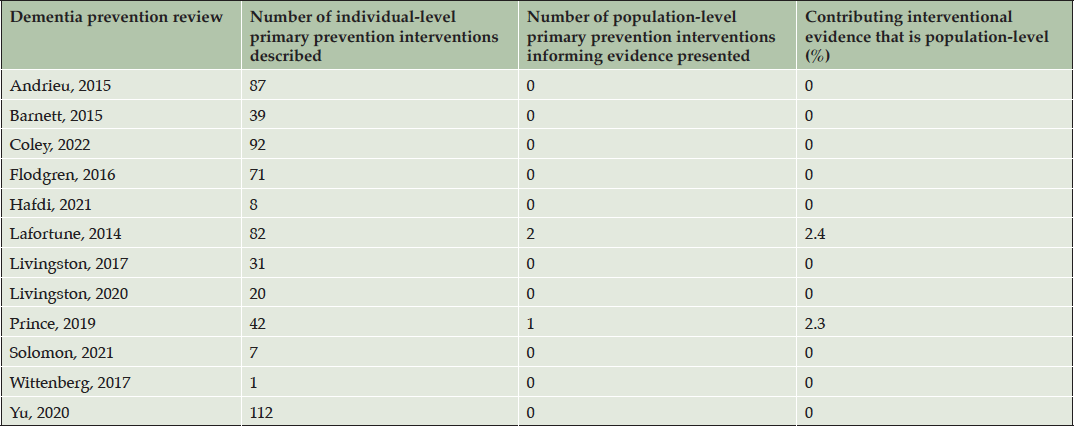
Table 3. Relative contribution of individual- and population-level evidence to the dementia prevention reviews
Search strategy analysis
The search strategy analysis is shown in table 4. For ten of the included reviews, it was considered possible that population-level evidence, if it existed, would have been captured by the search strategies. However, several of the strategies favoured the identification of individual-level evidence, either by predominantly using individual-level interventions terms (e.g. nutritional supplements, drugs) (16, 17, 20, 22, 24), or by including only those interventions that have been subjected to a randomised control trial (14, 15, 18). The two reviews by national public health agencies (21, 23) adopted more inclusive intervention terms (i.e. not limiting the prevention search terms to specific intervention words), but as a result had to restrict the number of results in other ways, either by only including existing reviews of evidence (21), or evidence that included explicit consideration of barriers and facilitators to intervention success (23). The search strategies of two reviews (7, 19) were not sufficiently described to allow for a judgement to be made.
RCT = Randomised Controlled Trial
Discussion
Main findings
Most reviews (83%, 10/12) of interventions for the primary prevention of dementia have reported exclusively individual-level interventions. In the minority (2/12) of reviews that did report some population-level interventions, these interventions represented a negligible amount (<2.5%) of the contributing evidence. The very small amount of contributing evidence that was population-level was predominantly related to increasing physical activity, mostly through mass media interventions to change socio-cultural norms. The search strategies used to inform the dementia primary prevention reviews were, in general, not designed to identify population-level interventions.
Strengths & Limitations
This rapid review was designed to produce a timely and pragmatic analysis of the extent to which current research summaries of dementia primary prevention interventions include population-level interventions. We searched only one academic database, limited to reviews published in the last decade, and included only reviews that summarised the breadth of the primary prevention evidence base. It is possible that a more comprehensive database search, and/or including reviews of single (groups of) risk factor(s), would have identified some extra reviews. However, it is unlikely that including one or two extra reviews would have significantly changed our findings.
Only one reviewer extracted information on population-level interventions contained in the reviews. This may have led to misclassification of some interventional evidence as not population-level evidence, which might have been spotted by a second reviewer. However, given the starkness of the findings, the overarching finding is highly unlikely to have been different, even if this was the case.
Findings in context
It is well established that primary prevention interventions that target individual-level behaviour change will achieve limited population impact alone (11, 32). Action on the social and commercial determinants of health through population-level policy can achieve greater direct population health benefit, and can also facilitate individual-level interventions to achieve greater impact (9–11). Hypothetically, individuals motivated to change behaviour (e.g. become more physically active) by individual-level interventions, will be much more likely to succeed if the environment around them is supportive of change, rather than reinforcing the original behaviour – many social and commercial factors will naturally pull in the opposing direction unless explicitly tackled through public health policy (11). Those most able to succeed in spite of societal conditions driving unhealthy behaviours are those with the most agency and resources – be they financial, cognitive, or social (32). Therefore, any dementia prevention policy derived from the existing literature, which this rapid review has demonstrated to be severely lacking in population-level interventions, is unlikely to significantly reduce dementia prevalence, nor to reduce existing health inequalities in incidence of dementia (33, 34).
Evaluating the impact of population-level interventions on dementia incidence is challenging because the outcome must be ascertained in the population at large, either through monitoring of diagnosis rates from routine healthcare data (which will be an underestimate and will reflect diagnostic practices and healthcare access) or through extrapolation of population-based cohorts (which is expensive, and may be underpowered). However, a recent systematic review, led by members of this author group, identified 45 economic studies of population-level interventions against the proposed modifiable risk factors for dementia (13). This indicates that some population-level evidence is available for curation and lobbying for translation into practice. The lack of population-level evidence in the included reviews of this paper, despite search strategies that could have theoretically identified it, suggests that dementia prevention researchers should explicitly place a focus on identifying population-level evidence when designing review methodology. The imbalance may also reflect a broader neglect of population-level action, with research itself being heavily shaped by the nature of investment – funders, research agencies, and publishers have a responsibility to address this by actively supporting and funding population-level evidence generation for the risk reduction of dementia (11, 35). Positive examples from other prevention agendas can be drawn from, for example the WHO’s ‘best buys’ which presents evidence-based policy recommendations for the prevention of non-communicable diseases, the majority of which are population-level interventions such as taxation, marketing restrictions, and public places smoking bans (36).
The need for more emphasis to be placed on population-level approaches within the dementia risk reduction research agenda was recognised in 2022 in the WHO’s blueprint for dementia research (8), the World Alzheimer Report 2022 (37), and Alzheimer’s Disease International’s, 2022 ‘From Plan to Impact Report V’ (38). This suggests there is traction within the research community to further this research agenda.
Conclusion
Existing systematic reviews of dementia primary prevention include almost exclusively evidence concerning individual-level interventions, and almost no evidence concerning population-level interventions. The search strategies used to inform these reviews were not generally designed to identify population-level interventions; but this imbalance may also reflect a broader, historical lack of emphasis placed on population-level prevention evidence generation by funders, policymakers, and publishers. There is emerging recognition that primary prevention of dementia, and the associated evidence base, needs to consider population-level approaches. This is necessary if dementia prevention policies are to achieve meaningful reductions in the prevalence of, and inequalities in, dementia.
Acknowledgements: None
Funding: SW is an NIHR Doctoral Fellow. The funders had no role in the design and conduct of the study; in the collection, analysis, and interpretation of data; in the preparation of the manuscript; or in The review or approval of the manuscript. WW is part funded by the National Institute for Health and Care Research (NIHR) Applied Research Collaboration East of England. The views expressed are those of the author(s) and not necessarily those of the NIHR or the Department of Health and Social Care.
Conflict of interest: The authors declare no conflicts of interest.
Open Access: This article is distributed under the terms of the Creative Commons Attribution 4.0 International License (http://creativecommons.org/licenses/by/4.0/), which permits use, duplication, adaptation, distribution and reproduction in any medium or format, as long as you give appropriate credit to the original author(s) and the source, provide a link to the Creative Commons license and indicate if changes were made.
References
1. Nichols E, Steinmetz JD, Vollset SE, et al. Estimation of the global prevalence of dementia in 2019 and forecasted prevalence in 2050: an analysis for the Global Burden of Disease Study 2019. Lancet Public Health. 2022;7(2). doi:10.1016/S2468-2667(21)00249-8
2. World Health Organization. Global status report on the public health response to dementia. Published online 2021.
3. Richard E, den Brok MGHE, van Gool WA. Bayes analysis supports null hypothesis of anti-amyloid beta therapy in Alzheimer’s disease. Alzheimer’s & Dementia. 2021;17(6):1051-1055. doi:https://doi.org/10.1002/alz.12379
4. Walsh S, King E, Brayne C. France removes state funding for dementia drugs. Published online 2019.
5. Walsh S, Merrick R, Richard E, Nurock S, Brayne C. Lecanemab for Alzheimer’s disease. BMJ. Published online December 19, 2022:o3010. doi:10.1136/bmj.o3010
6. Wolters FJ, Chibnik LB, Waziry R, et al. Twenty-seven-year time trends in dementia incidence in Europe and the United States: The Alzheimer Cohorts Consortium. Neurology. 2020;95(5). doi:10.1212/WNL.0000000000010022
7. Livingston G, Huntley J, Sommerlad A, et al. Dementia prevention, intervention, and care: 2020 report of the Lancet Commission. Lancet. 2020;396(10248):413-446. doi:10.1016/S0140-6736(20)30367-6
8. World Health Organization. A Blueprint for Dementia Research.; 2022.
9. Rose GA, Khaw KT, Marmot M. Rose’s Strategy of Preventive Medicine: The Complete Original Text. Oxford University Press, USA; 2008.
10. Walsh S, Govia I, Wallace L, et al. A whole-population approach is required for dementia risk reduction. Lancet Healthy Longev. 2022;3(1):e6-e8.
11. Walsh S, Merrick R, Brayne C. The relevance of social and commercial determinants for neurological health. Lancet Neurol. 2022;21(12):1151-1160. doi:10.1016/S1474-4422(22)00428-8
12. Ouzzani M, Hammady H, Fedorowicz Z, Elmagarmid A. Rayyan—a web and mobile app for systematic reviews. Syst Rev. 2016;5(1):210. doi:10.1186/s13643-016-0384-4
13. Walsh S, Brain J, Mukadam N, et al. A systematic review of the cost-effectiveness of community and population interventions to reduce the modifiable risk factors for dementia. Maturitas. 2022;166:104-116. doi:10.1016/j.maturitas.2022.09.002
14. Coley N, Giulioli C, Aisen PS, Vellas B, Andrieu S. Randomised controlled trials for the prevention of cognitive decline or dementia: A systematic review. Ageing Res Rev. 2022;82:101777. doi:10.1016/j.arr.2022.101777
15. Yu JT, Xu W, Tan CC, et al. Evidence-based prevention of Alzheimer’s disease: Systematic review and meta-analysis of 243 observational prospective studies and 153 randomised controlled trials. J Neurol Neurosurg Psychiatry. 2020;91(11). doi:10.1136/jnnp-2019-321913
16. Solomon A, Stephen R, Altomare D, et al. Multidomain interventions: state-of-the-art and future directions for protocols to implement precision dementia risk reduction. A user manual for Brain Health Services—part 4 of 6. Alzheimers Res Ther. 2021;13(1). doi:10.1186/s13195-021-00875-8
17. Barnett JC, Bahar-Fuchs A, Cherbuin N, Herath P, Anstey KJ. Interventions to prevent cognitive decline and dementia in adults without cognitive impairment: a systematic review. J Prev Alzheimers Dis. Published online 2015. doi:10.14283/jpad.2015.36
18. Andrieu S, Coley N, Lovestone S, Aisen PS, Vellas B. Prevention of sporadic Alzheimer’s disease: Lessons learned from clinical trials and future directions. Lancet Neurol. 2015;14(9). doi:10.1016/S1474-4422(15)00153-2
19. Livingston G, Sommerlad A, Orgeta V, et al. Dementia prevention, intervention, and care. The Lancet. 2017;390(10113):2673-2734.
20. Hafdi M, Hoevenaar-Blom MP, Richard E. Multi-domain interventions for the prevention of dementia and cognitive decline. Cochrane Database of Systematic Reviews. 2021;2021(11). doi:10.1002/14651858.CD013572.pub2
21. Flodgren GM, Berg RC. Primary and Secondary Prevention Interventions for Cognitive Decline and Dementia : Overview of Reviews.; 2016.
22. World Health Organization. Risk reduction of cognitive decline and dementia: WHO guidelines. Published online 2019.
23. Wittenberg R, Karagiannidou M, Knapp M. Primary prevention of dementia: barriers and facilitators. London: Public Health England. Published online 2017. Accessed May 30, 2021. https://assets.publishing.service.gov.uk/government/uploads/system/uploads/attachment_data/file/633100/primary_prevention_of_dementia_barriers_and_facilitators.pdf
24. Lafortune L, Martin S, Kelly S, Kuhn I, Cowan A, Brayne C. Disability, Dementia and Frailty in Later Life: Mid-Life Approaches to Prevent of Delay the Onset of These Conditions.; 2014. http://www.iph.cam.ac.uk
25. World Health Organization. Global Strategy to Reduce the Harmful Use of Alcohol. World Health Organization; 2010.
26. Liu JJ, Davidson E, Bhopal RS, et al. Adapting health promotion interventions to meet the needs of ethnic minority groups: Mixed-methods evidence synthesis. Health Technol Assess (Rockv). 2012;16(44). doi:10.3310/hta16440
27. Wu S, Cohen D, Shi Y, Pearson M, Sturm R. Economic analysis of physical activity interventions. Am J Prev Med. 2011;40(2). doi:10.1016/j.amepre.2010.10.029
28. Leavy JE, Bull FC, Rosenberg M, Bauman A. Physical activity mass media campaigns and their evaluation: A systematic review of the literature 2003-2010. Health Educ Res. 2011;26(6). doi:10.1093/her/cyr069
29. Cleland V, Granados A, Crawford D, Winzenberg T, Ball K. Effectiveness of interventions to promote physical activity among socioeconomically disadvantaged women: A systematic review and meta-analysis. Obesity Reviews. 2013;14(3). doi:10.1111/j.1467-789X.2012.01058.x
30. Cleland CL, Tully MA, Kee F, Cupples ME. The effectiveness of physical activity interventions in socio-economically disadvantaged communities: A systematic review. Prev Med (Baltim). 2012;54(6). doi:10.1016/j.ypmed.2012.04.004
31. Abioye AI, Hajifathalian K, Danaei G. Do mass media campaigns improve physical activity? a systematic review and meta-analysis. Archives of Public Health. 2013;71(1). doi:10.1186/0778-7367-71-20
32. Marteau TM, Rutter H, Marmot M. Changing behaviour: an essential component of tackling health inequalities. bmj. 2021;372.
33. Lai KY, Webster C, Kumari S, Gallacher JEJ, Sarkar C. Association between individual-level socioeconomic position and incident dementia using UK Biobank data: a prospective study. The Lancet. 2022;400:S56. doi:10.1016/S0140-6736(22)02266-8
34. Walsh S, Govia I, Peters R, et al. What would a population-level approach to dementia risk reduction look like, and how would it work? Alzheimer’s & Dementia. 2023;n/a(n/a). doi:https://doi.org/10.1002/alz.12985
35. Lincoln P, Fenton K, Alessi C, et al. The Blackfriars Consensus on brain health and dementia. The Lancet. 2014;383(9931):1805-1806.
36. World Health Organization. Tackling NCDs: “best Buys” and Other Recommended Interventions for the Prevention and Control of Noncommunicable Diseases. World Health Organization; 2017. https://apps.who.int/iris/handle/10665/259232
37. Alzheimer’s Disease International. World Alzheimer Report 2022 – Life after Diagnosis: Navigating Treatment, Care and Support.; 2022.
38. Alzheimer’s Disease International. From Plan to Impact V. WHO Global Action Plan: The Time to Act Is Now.; 2022.
© The Authors 2023

